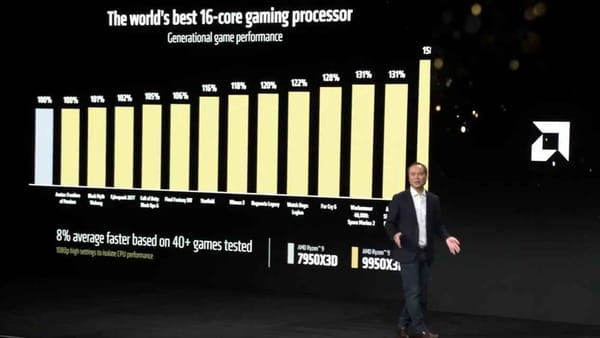AMD Announces New Gaming CPUs, and Somehow RDNA 4 Too



At CES 2025, AMD announced new CPUs for desktop, mobile and handheld gaming. GPUs based on the RDNA 4 architecture were also unveiled, although they were missing from the keynote.
AMD announced new gaming products for desktop, mobile and handheld gaming at CES 2025. The company unveiled new Ryzen 9900X3D and 9950X3D series desktop processors, as well as its second-generation handheld gaming PC processor - the Ryzen Z2. And while the new RDNA 4 architecture graphics cards were not part of the keynote, new desktop GPUs were also announced.
"Gaming has become the one of the biggest forms of entertainment around the world, and with titles becoming more immersive and demanding, having the right hardware and software is critical for the best player experience," said Jack Huynh, senior vice president and general manager, Computing and Graphics Group, AMD. "Today's announcements underscore our commitment to providing gamers everywhere the freedom to choose their own gaming experiences without being held back by performance bottle necks."
The Ryzen 9950X3D is a 16-core processor with 16 Zen 5 CPU cores and AMD RDNA 2 graphics - with 144 MB of 2nd generation AMD 3D V-Cache technology. AMD: "The new generation of X3D processors relocates the cache memory below the core complex die (CCD), placing 'Zen 5' cores closer to the cooling solution, to deliver higher clock speeds at lower temperatures and providing better performance compared to the previous generation." The Ryzen 9900X3D has 12 cores and 140 MB of total cache. Both CPUs will be available in March 205.
Three variants of the Ryzen Z2 processor have been announced for handheld devices, featuring up to eight Zen 5 CPU cores and RDNA 3.5 architecture-powered graphics with low power optimisations. According to AMD, the processors will be seen in devices from partners, including "Legion Go, ROG Ally and Valve Steam Deck." Shortly thereafter, Valve spoke out and stated pretty clearly: "There is and will be no Z2 Steam Deck."
"At Lenovo, we're shaping the future of gaming by delivering innovative solutions from powerful high-performance laptops and towers to handheld devices. With AMD's cutting-edge Ryzen Z series processors, we're pushing the boundaries of what handheld gaming devices can achieve," said Jun Ouyang, Senior Vice President and General Manager, Consumer Segment, Intelligent Devices Group, Lenovo. "Together with AMD, we have reimagined how gamers interact with their technology across every platform, and we are committed to driving the next generation of gaming innovation that adapts to the evolving needs of gamers everywhere."
The company also introduced the Ryzen 9000HX series for mobile notebooks - re-engineered with 2nd generation 3D V-Cache technology. At the top of the stack, the Ryzen 9955HX3D is said to be one of the fastest mobile processors with up to 16 cores. "Asus has always been at the forefront of innovation to help gamers reach their true potential," said Samson Hu, co-CEO, Asus. "With the new ROG systems powered by the AMD Ryzen 9000HX Series processors, gamers can push their limits and experience extreme power and performance in top-of-the-line notebooks."
However, AMD did not include the unveiling of the RDNA 4 architecture for GPUs in the keynote. Instead, media partners were briefed beforehand. There's not even a press release at the moment. Anyway: the upcoming 4nm chips will have optimised Compute Units and better AI and raytracing performance. The Radeon RX 9070 XT and RX 9070 are the first GPUs based on the RDNA-4 architecture and are expected to be released in the first quarter of 2025. It is worth noting that the naming scheme for the graphics cards has changed, probably to make them more comparable with their own CPUs and Nvidia's products (e.g. Radeon RX 7800 XT), but also in terms of expected performance. AMD did not provide any further information, but Asus confirms that both graphics cards will be released with 16 GB of graphics memory.
AMD's FidelityFX Super Resolution 4 (FSR 4) upscaling system will also be upgraded with AI features and, unlike previous generations, it will be hardware-based with dedicated AI accelerators. This means that FSR 4 will only work on 90-series GPUs - at least FSR 4 was mentioned as an AI feature in AMD's keynote and will be implemented in Call of Duty: Black Ops 6. This seems to be the end of hardware independent FSR implementation. In addition, AMD Anti-Lag 2 will further reduce input lag.